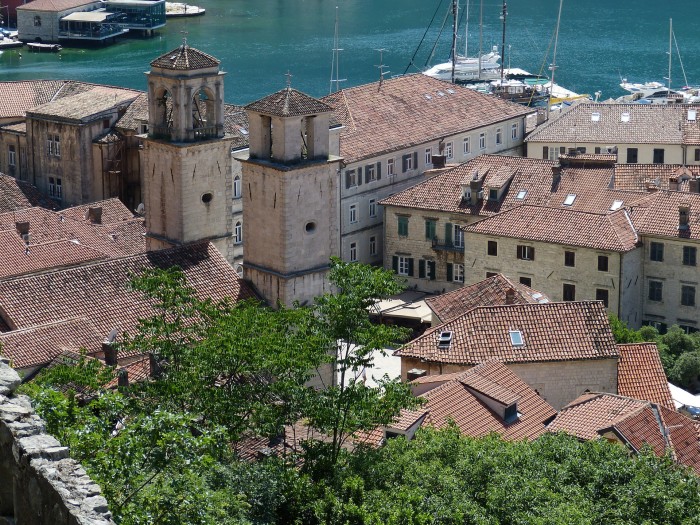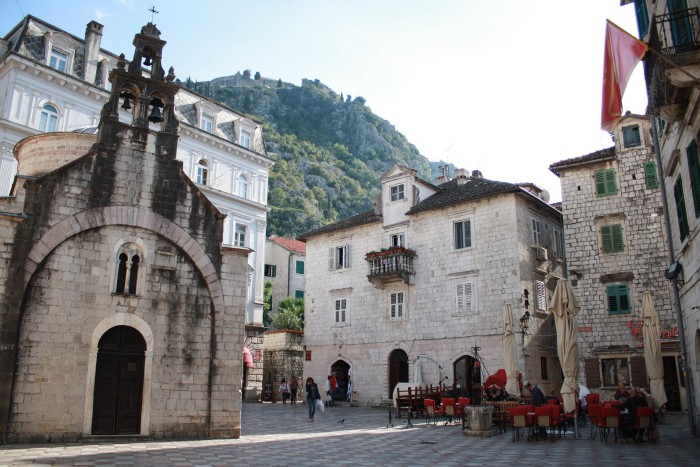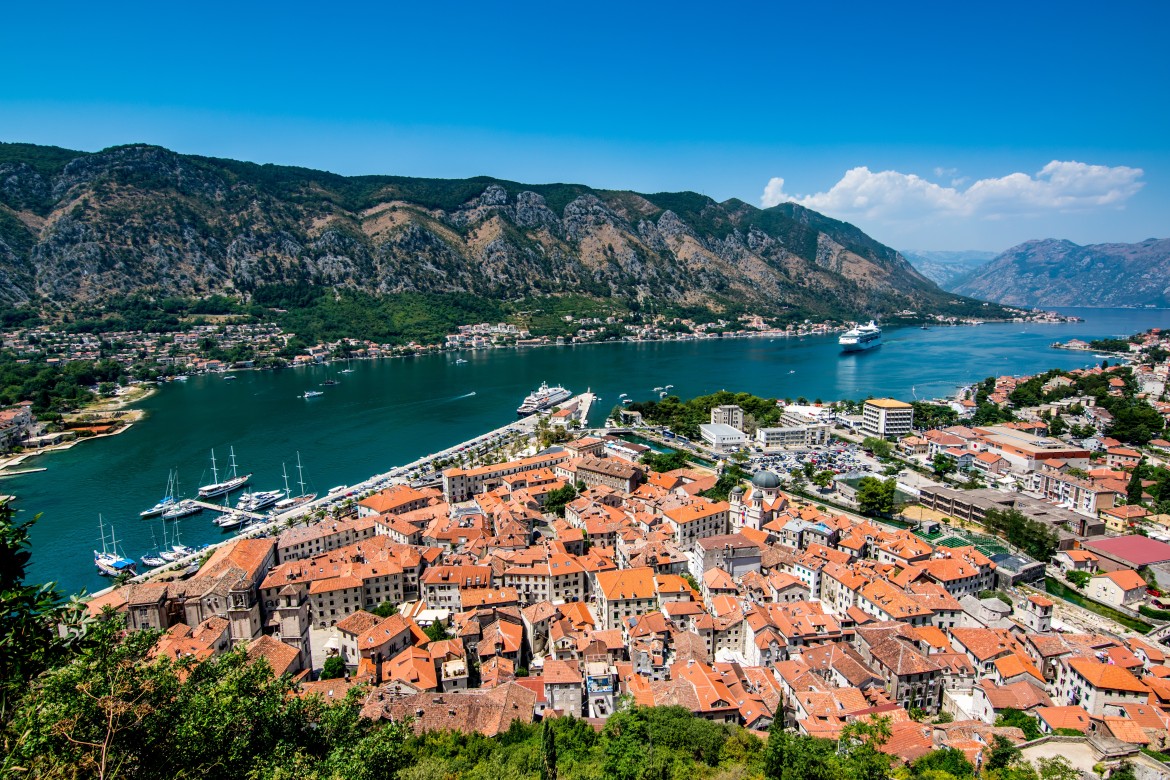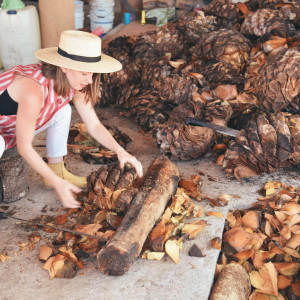Wedged between the calm waters of the east Adriatic Sea and the steep Dinaric Alps, Kotor is a small Montenegrin town that boasts rich history, riddled with a plethora of cultural influences. For tourism, Kotor has often been overshadowed by more opulent Italian getaways or even nearby towns such as Dubrovnik. There is an undeniable charm in Kotor though that is quietly, but steadily attracting an increasing number of suitors – whether that’s the quaint atmosphere, the rugged natural landscape surrounding it, or perhaps the captivating fusion of the two.
If you know where to look, you will be able to distinguish traces of Kotor’s rich history and diverse influences. More than any other, the 400 years of Venetian presence can be felt on every step of its narrow, cobbled streets —from the elegant façades that grace its palazzo’s to the lilting cadence of local dialect, infused in no small part with Italian loanwords. The spirit of brotherhood and unity, former Yugoslavia’s official slogan that was meant to bridge divides between its many ethnical groups, is embodied either in the harmonious co-existence of Catholic and Orthodox churches or the fact that one can go to a relaxed Italian-style café and sip strong Turkish coffee ordered from a menu written in Cyrillic alphabet. The unbreakable bond with history is nurtured through age-old festivities that still take place in the bay every year. The most important one is the Carnival, when residents of the town ritually dress up in costumes and burn a doll that signifies all the bad things that happened in the past year. Another one, Boka Night, marks the town’s maritime heritage in a ceremony where decorated boats sail around the bay and the most creative ones receive awards. Historically, these fiestas used to be a cause for the local community to get together and celebrate; nowadays they also represent one of the major selling points in town’s tourist offer.


Kotor’s historical beginnings were marked with turmoil, as powers from both east and west were eager to seize their piece of the Mediterranean. Finally, the town voluntarily came under the rule of Republic of Venice in 1420, which allowed Kotor to flourish into an important maritime trade hub. In the 20th century, Kotor joined the newly-independent Montenegro, which became one of the six republics of socialist Yugoslavia after World War Two. As home to one of the biggest shipping companies in the region, Kotor maintained its role as a maritime center in the new political system. The 1990s represented a turbulent period for the town due to the violent break-up of Yugoslavia, which brought about collapse of the shipping industry as one of its many disastrous side effects. Since then, the town has managed to revitalize its economy by parting from its maritime tradition and focusing instead on developing its potential as a tourist attraction.

Like any other community that has been affected by mass tourism, Kotor also risks erosion of its distinct identity in an effort to appear more palatable to seasonal visitors. Fortunately, locals are determined to utilize the increased exposure as a tool to preserve the town’s spirit in meaningful and innovative ways. The push to transform Kotor’s rustic Mediterranean setting into a stage for fresh ideas has resulted in cultural manifestations like KotorArt, a festival which puts on events dedicated to classical music, theater, architecture and philosophy in venues across the Old Town. Kotor’s more alternative edge is expressed through SeaRock Festival, which takes place on the old ramparts overlooking the sea and has so far hosted renowned indie acts like Wilco and William Fitzsimmons.

Efforts like these have prevented Kotor from becoming yet another southern European resort that has little to offer outside of generic seafood restaurants and souvenir shops. It remains to be seen whether this continues to be the case even as mass tourism becomes increasingly aggressive. Until then, the example of Kotor and how it managed to reconcile its beautiful Mediterranean heritage with its creative, rough-around-the-edges character can be a valuable lesson on how to preserve identities of small communities that heavily rely on tourist industry.
To spend a day or week there is to bask in the sun on the water take in a number of historic and architectural wonders. Lined with crimson roofs and stone churches and the bay stretching around a jagged shoreline and precipitous peaks, there lies a multitude of sights to see on foot, bicycle, car, or boat.
Go for a boat tour and cruise the Adriatic
Sailing into Kotor is undoubtedly one of the most popular attractions; and in winter, due to lack of tourists, you’ll likely have a stunning panorama of clear blue waters surrounded by a backdrop of tree-lined mountains, and colorful buildings in the distance all to yourself. Though some sail in to the bay, you can also catch a boat in front of Sea Gate, offering three to four hour tours for roughly thirty euro per person. Once out on the water there are several sights.
Be sure to see the Blue Cave, where you can hop off and swim around. // Our Lady of the Rocks Church is not to be missed. Created by sinking old and seized ships filled with rocks, the artificial islet holds the Roman Catholic church with a museum attached (and gift shop). Legend has it it that the islet was made by Croat seamen, keeping an ancient oath after discovering Madonna and Child on the rock. After each safe return from the sea, a stone was laid in the bay, and over time, the islet emerged. Throwing rocks has remained a custom—in July fašinada takes place where locals take their boats out and throw rocks into the sea to widen the surface of the island. // Walk around Fortress Mamula and learn about the history of the prison island used in both WWI and WWII that become a concentration camp famous for its cruelty. Despite it’s horrific background, the ruins now are abandoned and untouched, exuding a raw beauty—foliage crawling over arched doorways, sunny stone paths with grass jutting out, and spiraling staircases.
Visit the cutest little town, Perast
Known as one of the most beautiful towns in Montenegro, Perast is a pocket-sized village on the bay that has stood over 1,000 years despite multiple sieges by the Byzantine Empire, Serbians, Hungarians, French, Austrians and finally as a part of Yugoslavia. Traverse quaint cobblestoned streets and imagine yourself in a medieval era.
Wander Old Town
A UNESCO World Heritage Site, the fortified city holds a number of ancient churches in town squares where locals bustle around, hanging flowers and laundry over the streets. You could walk endlessly in the serpentine streets, winding around the picturesque landscape. Once tired, sit down at one of the many restaurants for some fish, or pop into the cat museum (one of the only two in the world).
Make the trek up to Castle of San Giovanni aka St. John’s Fortress
The fortified walls that ascend the bluffs, clinging to the cliffs of the Castle of San Giovanni are a wonder in themselves. They also make for a glorious hike to take in some of the most spectacular views the town has to offer. At 1,355 steps to reach the top, the climb is not for the faint of heart; however with each bit of elevation, the views grow even more stunning, and ultimately very worth it in the end. The panoramic vistas here are unrivaled.
Feature photography by Faruk Kaymak











Leave a reply